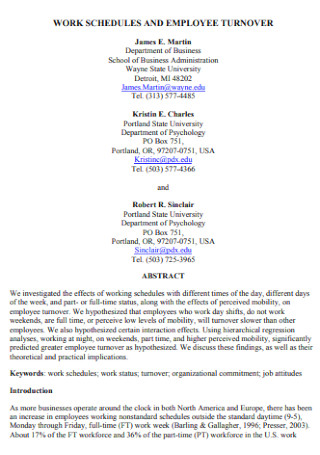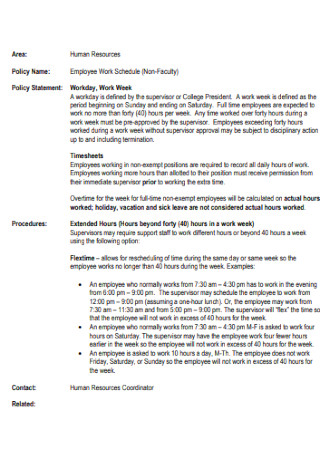21+ Sample Employee Work Schedules
-

Employee Work Schedule and Assigned Tasks
download now -

Employee Flexible Work Schedule
download now -

Employee Daily Work Schedule
download now -

Sample Employee Work Schedule
download now -

Sample Employee Alternative Work Schedule
download now -

Work Schedule for Part Time Employee
download now -

Employee Work Schedule Format
download now -

Work Schedules for Civilian Employees
download now -

Work Schedule and Employee Turnover
download now -

Law Employee Work Schedule
download now -

Standard Employee Work Schedule
download now -

Employee Daily Flexible Work Schedule
download now -

Basic Employee Work Schedule
download now -

Employee Alternative Work Schedule
download now -

Employee Weekly Work Schedule
download now -

Certificated Employee Work Schedule
download now -

Policy on Employee Work Schedule
download now -

Non-Faculty Employee Work Schedule
download now -

Staff Work Schedule
download now -

Employee Daily Work Schedule
download now -

Employee Request for Work Schedule
download now -

Office Employee Work Schedule
download now
FREE Employee Work Schedule s to Download
21+ Sample Employee Work Schedules
What is an Employee Work Schedule?
Importance of an Employee Work Schedule
Types of Employee Work Schedules
Basic Elements of an Employee Work Schedule
Tips on Making an Effective Employee Work Schedule
FAQs
What are Common Work Schedules?
What is the Ideal Work Schedule?
What is Work Scheduling?
An Employee Work Schedule is among many types of work schedules and this is commonly utilized by businesses of all kinds, be it big or small. We provide 21+ employee work schedules that your business may use as reference and to ultimately adopt to ensure the efficiency of the business operations and to maximize the productivity of your employees and most importantly, aid them so they never have to miss a day at work.
What is an Employee Work Schedule?
An employee work schedule is basically a schedule that records the specific days and the times an employee is supposed to clock in for work. Besides monitoring the employees’ attendance and their performance, it also indicates the duration an employee is supposed to actually work and for some cases which really just depends on the scheduling format that your company follows, it can also indicate the locations and the specific tasks an employee is expected to accomplish within the working hours assigned to them.
Importance of an Employee Work Schedule
It is of utmost importance that companies employ an employee schedule as an understanding of when an employee is supposed to work guarantees them to focus on performing their roles better. And, when the workplace is able to display efficiency, the company’s overall productivity improves. For those in HR or those with managerial positions who oversee the work schedules, they are assured that important tasks are prioritized and maximum efficiency is achieved which in their case could signal work completion.
Aside from the general importance of an employee schedule, we cite a few more reasons as to why businesses consider it necessary to create an employee work schedule.
Types of Employee Work Schedules
1. 9-to-5 Work Schedule
A common work schedule is one that requires employees to work the standard business hours usually from 9AM-5PM from Monday all the way to Friday. The days and the time may vary depending on the company but for as long as it asks from the employees to render 8 hours of service 5 days a week that would still be considered as the standard 9-to-5 work schedule. This also includes an hour-long lunch break.
2. Full-Time Work Schedule
This specific schedule requires employees to work 37-40 hours on a weekly basis as indicated in the Fair Labor Standards Act (FLSA) amended by the Congress in 1940. The employees then are given the freedom to choose the number of days they want to work for as long as they consume the required working hours. While a limit on the hours is imposed, it does not necessarily mean that employees cannot work beyond 40 hours. It just means that if they do they would be working overtime and should be entitled for compensations like overtime pay. While this is the ideal schedule for the employee as they can receive benefits such as paid medical leaves, it could actually get costly for the employer for the same reason. The latter could also be facing difficulties in filling in positions that require overtime work.
3. Part-Time Work Schedule
A simplified description would be the opposite of how a full-time schedule is defined, meaning it is the type of schedule that requires a part-time employee to not work the regular 8 hours per day the same way a full-time employee is supposed to. While they are not entitled to the same benefits a full-time employee is enjoying, they are more available to take on tasks due to the flexibility offered by the setup.
4. Flexible Work Schedule
Flexible schedules gives employees the same freedom full-time employees have in choosing when they want to work except in this case, it includes having the freedom to choose which days they want to clock in for work as well as the time of their arrival and the time of their departure as long as they complete the standard 8 hours of work per day. However, companies can still impose strict flexible schedules where they set the times an employee is supposed to arrive and leave. While it does have disadvantages like how it may not be the best way for the workplace to form the kind of relationships collaborative work requires, it is the type of schedule that is favorable to aspiring applicants who appreciate still having the time to spend outside working hours and especially those that have responsibilities of raising their families or other commitments such as graduate studies and other avenues of generating income.
5. Shift Work Schedule
For companies that operate more than 10 to 24 hours a day, they tend to divide the day in shifts and require employees to work in rotations: a number of employees work the early morning shifts and the rest during the night. Most occupations that have no choice but to work under this particular schedule include healthcare professionals, fast food chain employees and retail workers. This is usually avoided because of its many disadvantages because it interferes with daily schedules and most importantly for how it dramatically impacts one’s sleep that consequently causes fatigue and insomnia. The shift work disorder is a condition that employees who work non traditional hours and have shift work schedules suffer from. According to the Sleep Foundation, 2 of its prominent symptoms are: insomnia and excessive sleepiness.
Basic Elements of an Employee Work Schedule
If you already have with you an employee work schedule that best fits the needs of your company, we list important elements that should be reflected on it although this may vary depending on the employment status of your employee.
- List the employees names
- Day and Time the employee chooses to work and leave
- The time the employee takes their lunch break
- The amount of hours the employees are are supposed to work
- The duties that need to be accomplished within their working hours
Tips on Making an Effective Employee Work Schedule
Developing a work schedule is no easy task. There is actually a lot more that goes on surrounding it besides what you already know that is more concerned with unexpected circumstances like understaffed hours and negotiating with upset employees. Because this is also something a potential employee looks into prior to their commitment or their interest in applying for the company, it is necessary to create a close to perfect work schedule that is at best flexible. However, it is not enough to draft the perfect format for the schedule. Its ability to mobilize your employee’s efficiency still lies in the implementation of the schedules.
Below are some of the helpful tips and some factors to take into consideration to make effective your employee work schedules.
1. Be sure the work schedule is mentioned during the hiring process.
This is crucial so those interested in working for your business are aware of what they might get into and if it matches their own schedules as well. Remember that when an employee is equipped with what they need to know and especially if it’s something as important as the amount of time they have to work and get things done, they can better perform their designated roles and it should improve the company’s output deliveries and overall productivity. Be as transparent as possible during the hiring process with regards to the schedule. If the job requires overtime and weekend attendance, then be upfront about it. A responsible employee should be able to gauge if the schedule fits them despite the conditions and if not, they can decline the job which works for both parties as the employee is saved from crunch time and extra time working and the employer is saved from incompetence that might derail the workplace’s progress.
2. Involve the Employees.
As much as possible, an employee work schedule has to be centered on the driving force of the business. You want the schedule to work best for the employees and in order to do so, they must have a say in it although the last call won’t be made by them, their feedback is still as vital. Take into consideration their availability and the shifts they prefer. However, we all live different lives so this should be something supervisors understand because even when the employees are given a chance to chime in with their opinions, what will be agreed upon by the majority still won’t appease some.
3. Know your team.
As emphasized, the process of work scheduling should be employee centered and as those with the authority and the responsibility of creating the work schedules, it helps to build relationships with your team. It doesn’t have to necessarily be on a personal level but just enough that you have information about maybe their work ethics or the time they feel they are able to perform more efficiently. On the other hand, knowing who you are working with can help you identify which employees may need additional training to improve their performance.
FAQs
What are Common Work Schedules?
Common work schedules are: Full-time and Part-time schedules, Flexitime schedules, Shift schedules, Rotational Schedules and the standard 9-to-5 schedule.
What is the Ideal Work Schedule?
An ideal work schedule is one that requires shorter working hours and could still give you a desirable income without having to be so stressed and burnt out. Obviously, that can’t be for employees who have yet to work their way up and no generational wealth in their arsenal.
An ideal work schedule is one that requires shorter working hours and could still give you a desirable income without having to be so stressed and burnt out. Obviously, that can’t be for employees who have yet to work their way up and no generational wealth in their arsenal. An ideal working schedule is a Flexible Work Schedule that gives you a semblance that you control your working hours. In fact, according to Prosky, it lists flexibility as top 3 factors that millennials’ want in a job.
What is Work Scheduling?
Smart scheduling is time well spent not only for the employees but for the business as well. Plan your schedules ahead to ensure that your business’ operations run smoothly.
